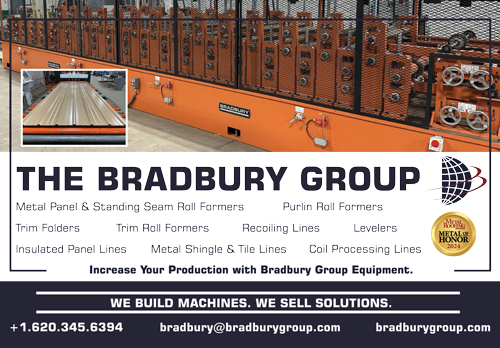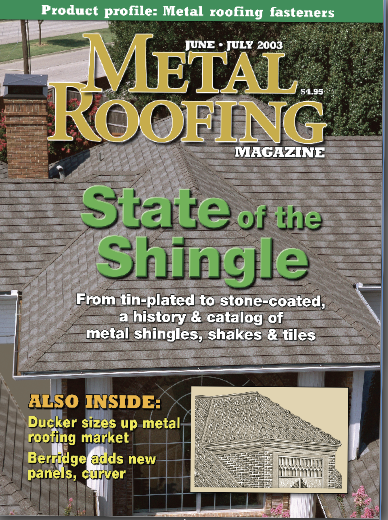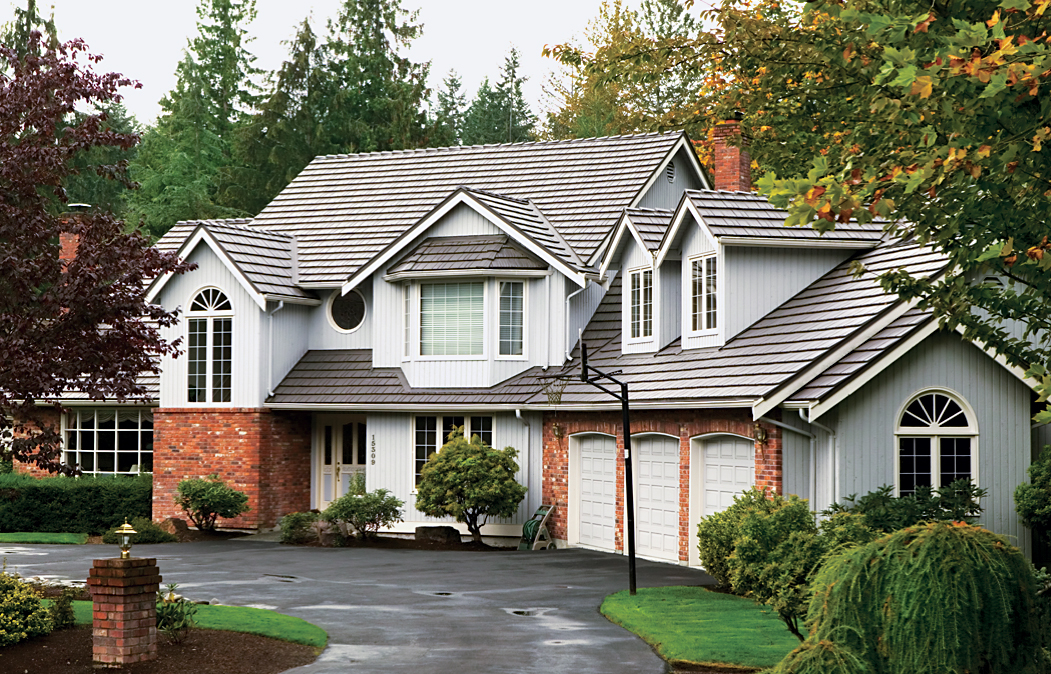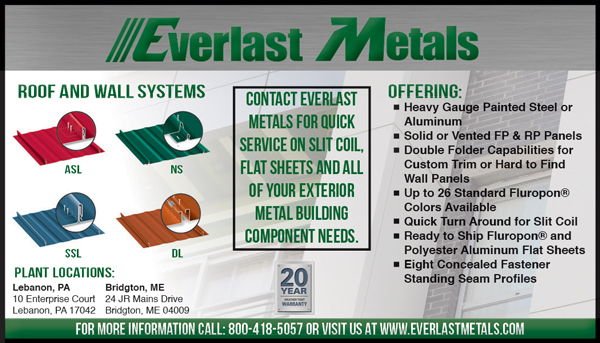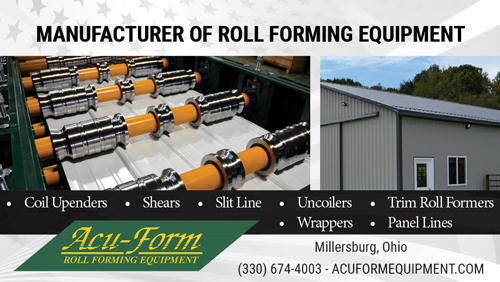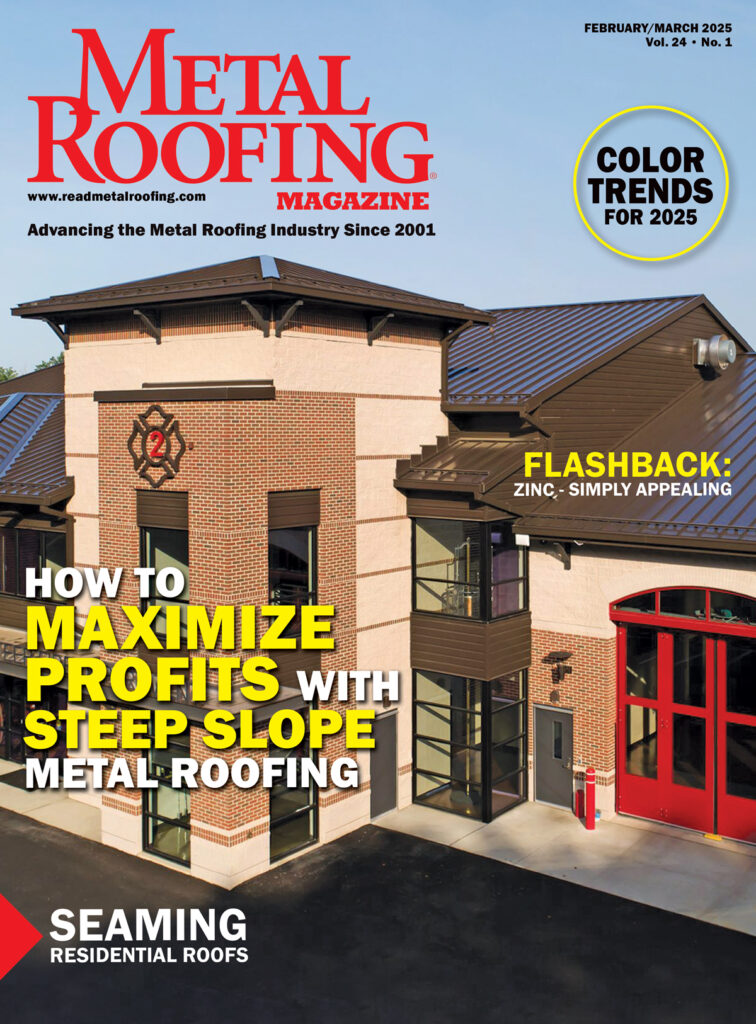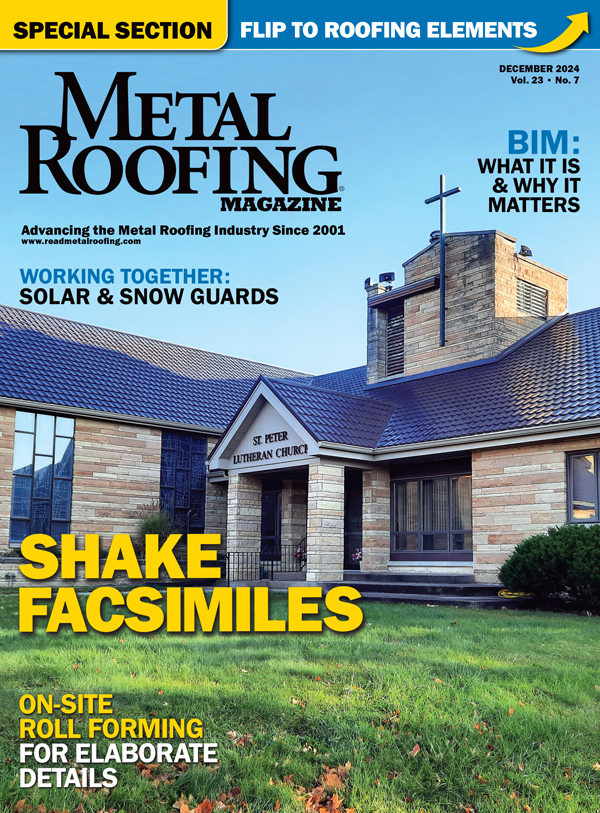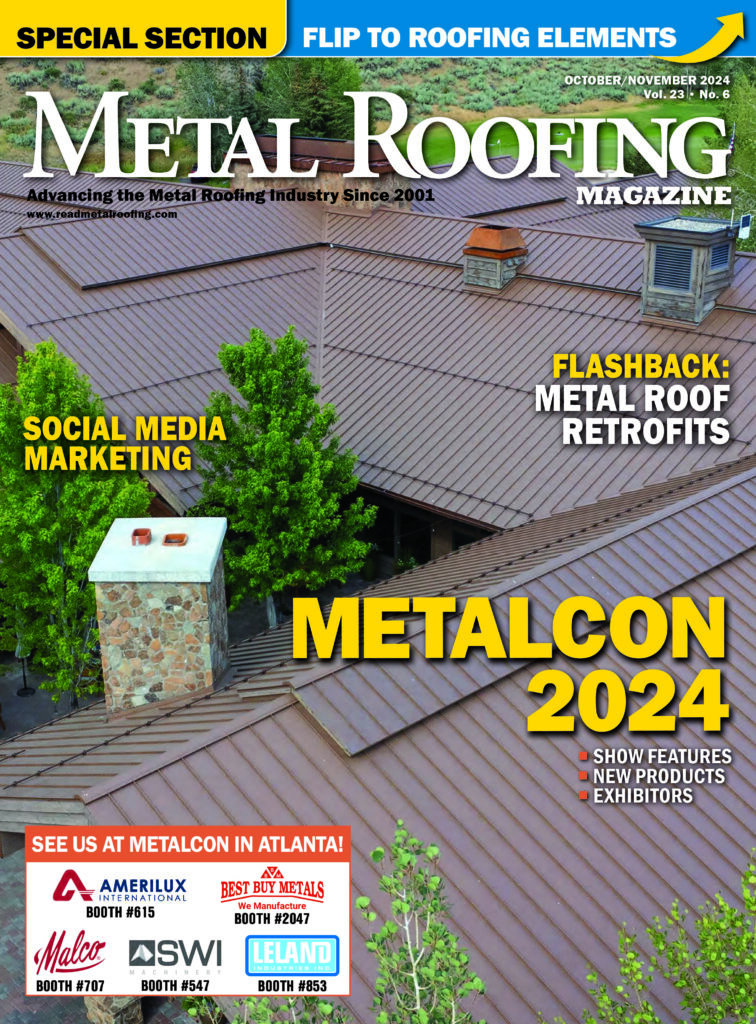Metal Roofing Magazine was born as a supplement to Rural Builder magazine in 1999. A few more supplements were published in 2000. In 2001 it was elevated to a stand-alone magazine, and today it is over 20 years old.
If you have a metal roofing project on an historic building, we’d love to see it, and share it with our readers!
Contact Karen Knapstein, [email protected], forwarding all the information you have about the materials used, challenges faced, and a few hi-res photos. In the meantime, enjoy a bit of metal roofing history!
Landing The Big Jobs
Selling metal roofing to homeowners associations is getting easier, some say
By Mark Ward, Sr.
Selling metal roofing to individual homeowners is a fairly straightforward proposition. By the time customers call they may have already experienced a roofing problem, have the means and motivation to solve it, and are intrigued by the durability and stylishness of a metal roof to protect their home investment.
But selling to a group of homeowners, as represented by their homeowners association, is not such a simple matter and may involve months of cultivating key individuals, making presentations before committees and boards, and staking it all on an up-or-down that the metal roofer may or may not win.
Why go through all the effort? “If you can sell a homeowners association and maybe even do the first metal roof in that community, your company will get great visibility that will probably lead to more jobs and more referrals,” explains Tony Tiapon, a Corona, Calif.-based zone manager for Decra Roofing Systems.
Todd Miller, president of Classic Products confirms the public relations value of installing the first metal roof in a residential area. “Remember, chances are that most of the homes in the area represented by the association were all built around the same time that the community was built,” he says. “So if one home needs a new roof, then a lot of the other homes are probably ready for re-roofing too.”
Word of mouth can work for you, too. “Board members and residents of one homeowners association talk to their counterparts in other nearby associations,” notes Jonathan Wilson, marketing manager for Ram Metal Roof Mart of Placentia, Calif. “As the word gets out about metal roofing installed in one community, our company is typically getting jobs in four or five homeowners associations per year.”
Cultivating the Association Board
In targeting homeowners associations, metal roofing contractors can divide their prospects into three distinct markets. One opportunity is to sell metal roofing to associations that are run by volunteer boards and which seek to re-roof community-owned buildings such as clubhouses and pool facilities.
A second market can be found among associations in which common buildings are maintained by a property management firm. Finally, the market includes individual homeowners who desire metal roofing but must obtain approval from their association to modify architectural covenants that currently prohibit metal roofs.
“Associations managed by boards and those run by property managers are two very different markets,” says Tiapon. In selling to a board-run association, “you’ve got to do a lot of homework. Since board members actually live in the community, what are their roofing preferences? Has the board kept up with the current realities of the re-roofing market? Have they assessed enough dues from the homeowners to adequately fund the project?”
As such, suggests Tiapon, a sales representative must be adept at cultivating board members, eliciting the necessary information, and making polished presentations. “It can take patience,” he counsels, “and may start with driving through the community, talking to individual homeowners, and then probing and asking questions and finding out who are the key decision makers on the board. That way, when you start calling up individual board members you won’t be shooting in the dark.”

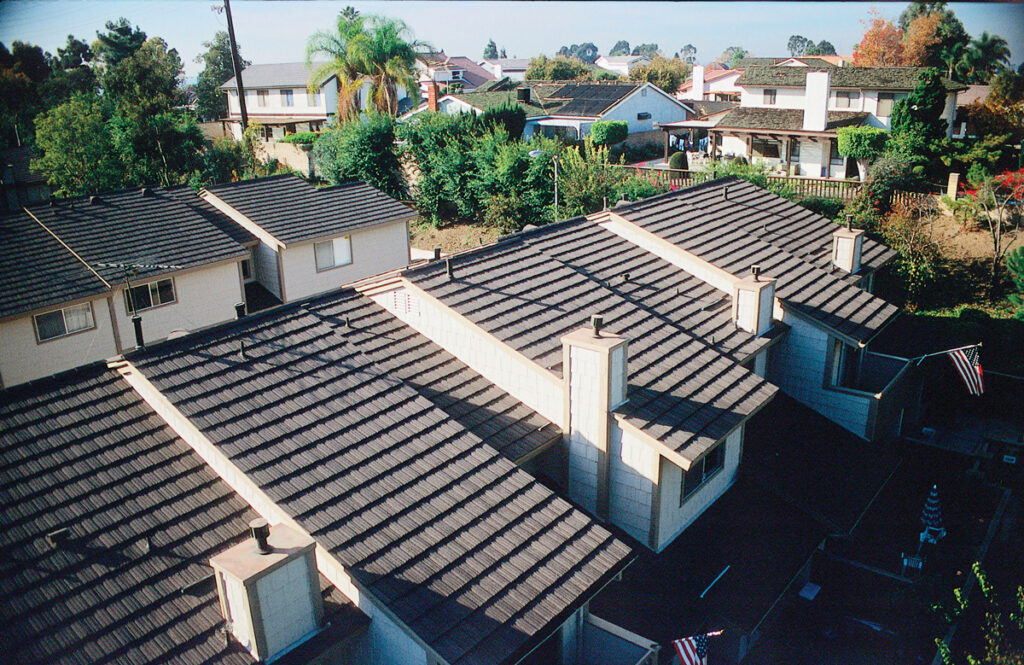
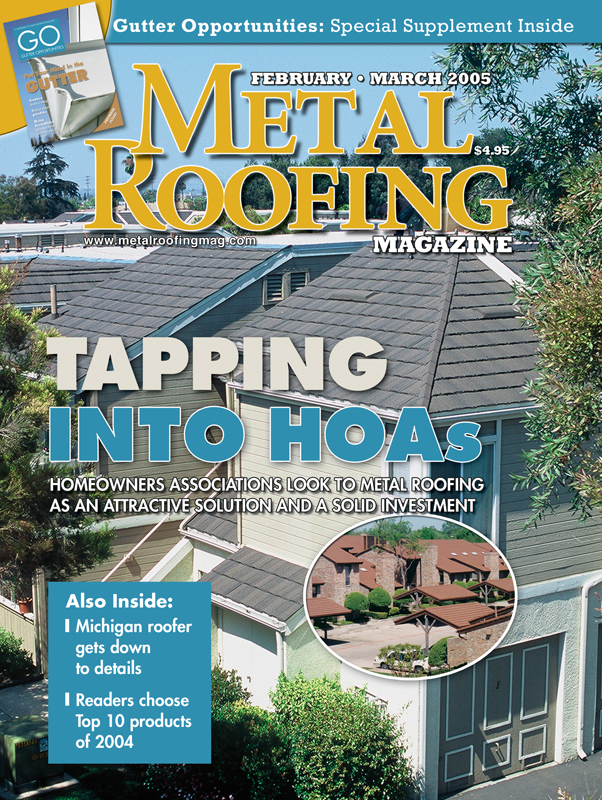
Tiapon believes selling starts with individual board members and building good rapport on a personal level. Here too, patience is often required as board members may change due to elections “and sometimes you might even have to start the process all over again,” he says. Yet cultivating individual relationships, he points out, is the key in eventually receiving an invitation to make a presentation before the entire association board.
“You can’t make a presentation unless you’re invited,” Tiapon says, “and association boards don’t just call you up and ask for your proposal. Long before anything happens, you’ve got to be cultivating individual members. You’ve got to be asking when the board meets, whether presentations are allowed and, if so, how they’re made. And only then can you ask if your company can make a presentation. The process can easily take a year.”
In between, Tiapon adds, contractors may have to get past a roofing committee or a roofing consultant, before they ever get to the level of the board itself. “Marketing to homeowners associations is usually something we do as a metal roofing manufacturer,” he says. “At Decra, my job as a zone manager includes cultivating association projects.”
Where the contractor comes into the process, he continues, “is when things start getting more serious and I’m looking at being able to make a presentation to the board. That’s when I partner with a contractor, because having his expertise as the installer makes the presentation more effective.” As for which contractors Tiapon seeks as partners, he says Decra and other manufacturers know which local roofers can handle association projects — which can range in value from $15,000 to millions.
Key selling points for volunteer boards are the price, durability, and water resistance of metal roofing, Tiapon says, and board members’ comfort level with the contractor and manufacturer. “Nine out of 10 times we’re in a bidding situation,” he explains, “and most of the time, if roofing products seem about the same, the board goes with the lowest price. But we get the board to look at life cycle costs. Our product lasts 50 years, compared to 10 years for asphalt. And since our roofs are lightweight, you can install them over the existing roof and maintain the original R-value.”
Should the manufacturer and contractor be successful in winning an association job, the roofer must be adequately insured “and able to keep the board or the property manager happy,” Tiapon says. “For example, you’ve got to keep the jobsite clean. Nothing is going to turn off an association more than a messy jobsite that’s an eyesore for the community.”
Marketing To Property Managers
Selling metal roofing to professional property managers “is also manufacturer-driven,” says Tiapon, “because many property management companies can be big operations that manage multiple homeowners associations. To be visible to these companies, we’ve got to go to the trade shows where we can meet their key people and develop relationships.”
In addition to price, durability, and aesthetics, Tiapon says technical specifications “are also important to property managers, since they’re professionals and know their jobs.” Nevertheless, he suggests that metal roofing contractors can enter the market by calling on property managers to offer full-service installation and repairs as needed.
“Contractors can also get in touch with their manufacturers,” Tiapon says, “and offer to attend trade shows and partner with the manufacturer in helping cultivate contacts.” Wilson says Ram Metal Roof Mart often partners with contractors “whom we know can handle association projects, usually because they specialize in metal roofing for these kinds of jobs.”
“Before a contractor typically becomes involved, a company like ours first has to go to the homeowners association and do some educating,” says Wilson. A board-run association may appoint a roofing committee that must be instructed about available products and material choices. By contrast, marketing to property management companies may require networking at national and state meetings of organizations like the Community Associations Institute.
Altogether, Wilson points out, the process may take three or even five years from the time an association thinks about re-roofing until the project is actually contracted. “The major selling points are that metal roofs have the durability to basically be a one-time expense, and that they’re maintenance-free and keep their aesthetics long-term,” Wilson says. “It’s also important that metal roofs are lightweight and therefore within the weight parameters of the original roof.”
The proliferation of roofing products over the years “has meant that some associations have been stung before with non-metal products that failed,” Wilson says. Because high-quality residential metal roofing has now been on the market for more than 20 years, he says, “If a homeowners association wants a proven track record, we can provide one. We can even give a 50-year warranty.”
As a result, Wilson reports an impressive rate of closing about half of the sales in which his company is invited to make a presentation. “If we don’t close the sale, it’s not because of the product but strictly on price,” he says. “Metal roofing costs more than asphalt and is competitive with concrete tiles, and superior as a product.”
Changing the Covenants
Marketing metal roofing to homeowners associations also comes into play “when an individual homeowner in a community has contacted us, but we can’t do the job until the association approves metal roofs in the first place,” says Miller.
Communities whose homes need re-roofing were often built in the 1960s or ’70s, Miller points out, before today’s newly developed metal roofing products and finishes were on the market. “So a lot of times the issue we’re facing is that the association’s covenants either expressly say no metal roofs, or say that only tiles or shakes are allowed,” Miller says. “And believe me, there are still a lot of communities that still have no homes with metal roofs.”
Miller says the challenge is compounded by the sheer number of homeowners associations. Many communities may be comprised of a dozen homes or less. Yet associations large and small can be zealous about protecting property values and aesthetically equate metal roofing with industrial or agricultural buildings.
“The key point you need to make to an association board,” Miller says, “is the fact that metal roofing products today are durable and have coatings and finishes that keep them looking good for years.” Taking board members or architectural review committees out to see actual examples of attractive residential metal roofs is a powerful selling tool, he says.
Miller recalls a homeowner in upscale Hilton Head, S.C., who sought a variance in his association’s architectural covenants to permit metal roofing. “So he put up a ‘temporary’ metal roof on his garage and then took a survey of all his neighbors,” Miller says. “Everybody really loved the roof and, as a result, the board changed the covenants.”
Metal roofing contractors who have been contacted by an individual homeowner already have an edge, Miller observes. “Remember, that homeowner lives in the community,” he notes, “so he or she has a voice in that community and a right to be heard by the board. Also, since the homeowner is probably fed up with his existing roof, he’s motivated to push for a change in the covenants.”
Even so, at times homeowners and contractors must be satisfied with compromises. “The board might not give a blanket approval to metal roofing,” Miller says, “and may only allow metal roofs if they simulate shakes or shingles. But at least today we have the products to do that for our customers.”
Whether marketing metal roofing for association-owned buildings or individual homeowners, Tiapon says, “the hardest step is breaking into your first project. After that, it becomes easier as a contractor to sell metal roofing to homeowners associations based on your experience. Our current closing ratio is now about 90 percent, once we’ve been invited to make a presentation, because we’ve got the product and the expertise.”
Miller agrees. “Selling to homeowners associations is getting easier all the time, now that metal roofing has generated some awareness in the market. Yet we’re still just scratching the surface. The number of homes that need re-roofing is only going to increase with time, and there are still thousands of communities all over the country where you can be the first contractor who puts in a metal roof.” MR



